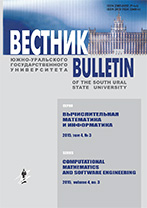|
This article is cited in 2 scientific papers (total in 2 papers)
Computational Mathematics
Modification of the matrix pencil method using a combined evaluation of signal poles and their inverses
O. L. Ibryaeva, D. D. Salov
South Ural State University (pr. Lenina 76, Chelyabinsk, 454080 Russia)
Abstract:
The Prony-like parametric method of signal processing, namely the Matrix Pencil Method, is considered in the paper. The method is able to find frequencies, damping factors, phases and amplitudes of a sinusoids sum. It needs fewer number of operations than Prony method and hence lower computational error. A modification of the method using a combined evaluation of signal poles and their inverses is proposed. This modification is able to solve the problem of true/false poles separation. Two matrix pencils with eigenvalues coinciding (in the absence of noise) with signal poles and their inverses are constructed from the signal samples. In case of noisy signal true/false poles separation is performed by: 1) SVD; 2) excessive order of prediction; 3) analysis of eigenvalues of two matrix pencils. Algorithms of the modified and classical Matrix Pencil Methods are given and compared on the example of signal detection in noise. It is shown that the classical method is not able to detect the time of arrival of the signal since it fits an exponential sum to the noise. The modified method can detect both the time of arrival and the signal frequency. The proposed algorithm of signal detection is suitable for use with signals of sufficiently general form (sum of decaying sine waves) and does not require distribution laws of signal and its noise component, as the maximum likelihood method.
Keywords:
signal processing, matrix pencil method, detection of signal in noise, unknown time of arrival, frequency estimation.
Received: 20.10.2016
Citation:
O. L. Ibryaeva, D. D. Salov, “Modification of the matrix pencil method using a combined evaluation of signal poles and their inverses”, Vestn. YuUrGU. Ser. Vych. Matem. Inform., 6:1 (2017), 26–37
Linking options:
https://www.mathnet.ru/eng/vyurv156 https://www.mathnet.ru/eng/vyurv/v6/i1/p26
|

| Statistics & downloads: |
| Abstract page: | 4118 | | Full-text PDF : | 309 | | References: | 52 |
|




 Contact us:
Contact us: Terms of Use
Terms of Use
 Registration to the website
Registration to the website Logotypes
Logotypes








 Citation in format
Citation in format 
